December 2024
The global low fat cheese market size accounted for USD 111.14 billion in 2024, grew to USD 115.05 billion in 2025 and is projected to surpass around USD 157.08 billion by 2034, representing a CAGR of 3.52% between 2024 and 2034. The Europe low fat cheese market size is calculated at USD 38.9 billion in 2024 and is expected to grow at a CAGR of 3.65% during the forecast year.
The global low fat cheese market size is calculated at USD 111.14 billion in 2024 and is predicted to reach around USD 157.08 billion by 2034, expanding at a CAGR of 3.52% from 2024 to 2034. The low fat cheese market growth is attributed to increasing consumer health consciousness and the expansion of innovative product offerings that cater to dietary preferences.
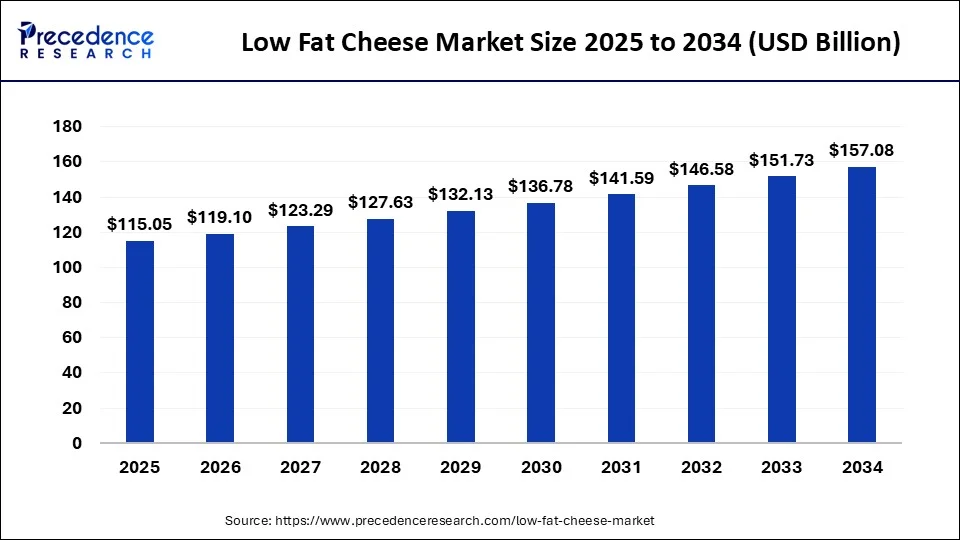
The Europe low fat cheese market size is evaluated at USD 38.9 billion in 2024 and is anticipated to be worth around USD 55.76 billion by 2034, growing at a CAGR of 3.65% from 2024 to 2034.
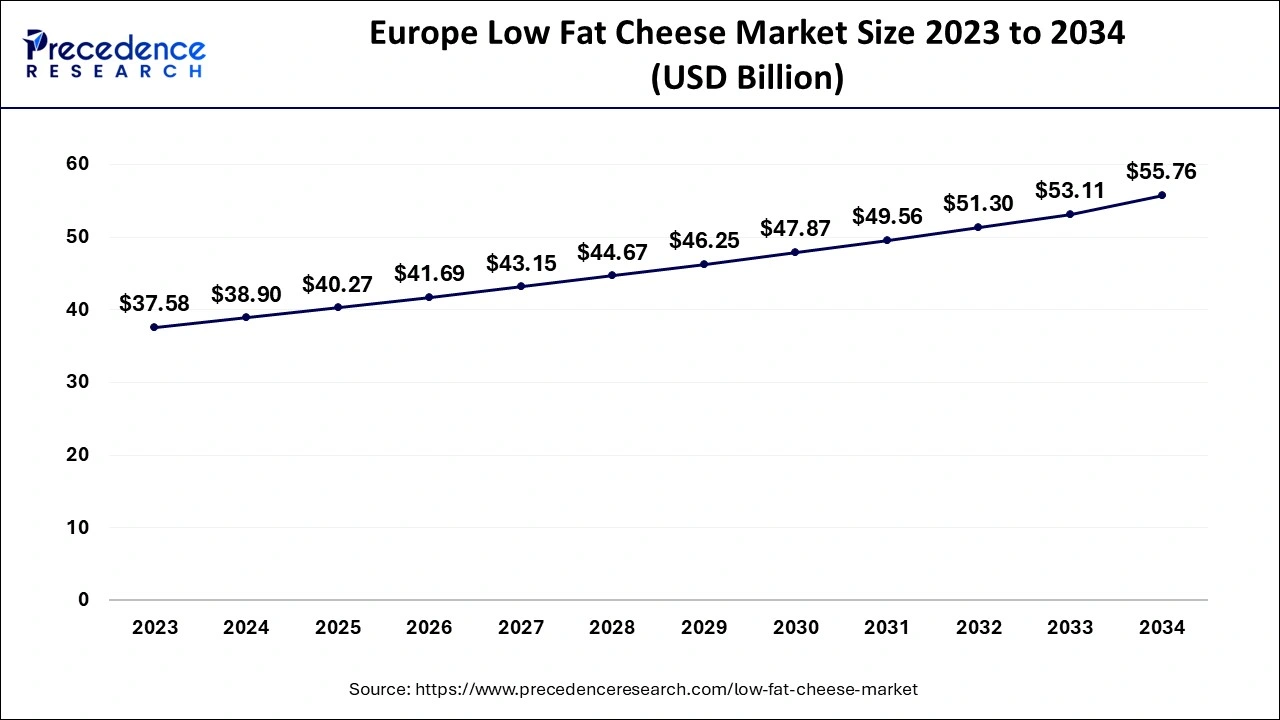
Europe dominated the global low fat cheese market in 2023 due to consumer awareness of trends and issues associated with health and well-being. Therefore, there is great potential in the region because it has been estimated that the it contains almost forty percent of the global market share, as estimated by Euromonitor International.
Another factor that boosted this growth was the FDA’s stand on labeling, which banned most claims related to nutrition and labeling and encouraged the use of low-fat products that offer more information on the importance of using low–fat products. Additionally, the increased incidences of lactose intolerance and the need for low-fat diets such as the Keto and Paleo diets further boost the demand for low-fat cheese products in this region.
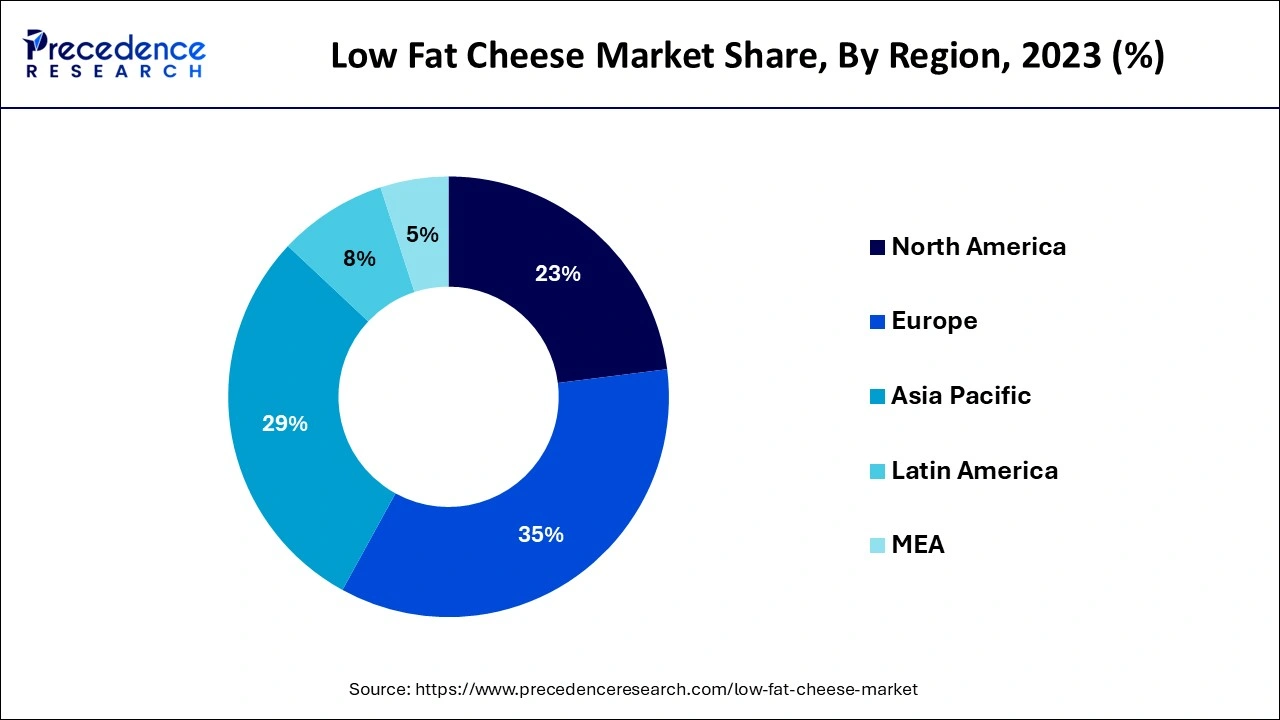
Asia Pacific is projected to host the fastest-growing low fat cheese market in the coming years, owing to the growing incidence of obesity and other diseases, such as diabetes and high blood pressure. The World Health Organization examines a significant increase in these health conditions in Asia; thus, consumers are shifting towards low-fat dairy products. Furthermore, over the years, due to developments in electronic commerce, including Alibaba and Flipkart, the availability has increased.
Consumer's global awareness of their health has a multiplier effect on the low fat cheese market. People are cautious about their fat intake and its effects on the human body, including obesity and cardiovascular diseases. Technological developments in the creative process for the formulation of foods have made it possible to produce low fat cheese that is acceptable in terms of taste and texture.
The Food and Agriculture Organization (FAO) notes that packaging has been enhanced by new innovative solutions that have led to shelf-life adjustment and enhanced distribution, thereby increasing the accessibility of these products. The low fat cheese market growth trajectory reflects the growing societal sensibility for bettering their health and the nutritional value of the products they consume, and it shows that low-fat cheese is an acceptable choice for fat-conscious individuals.
Impact of Artificial Intelligence on Low Fat Cheese Market
Artificial intelligence is being integrated into sectors of the food industry by increasing and enhancing productivity in production quality control and supply chains. AI in the low fat cheese market allows the identification of changes in factors, such as temperature, humidity, and bacterial culture growth, that affect the quality of the final product to be improved. Data analytics powered by artificial intelligence allow companies to better anticipate demand and thereby smoothly avoid problems with overstock or stockout. Additionally, AI helps to develop recipes that do not affect the taste and texture profile of products, further creating demand for low-fat cheese products.
| Report Coverage | Details |
| Market Size by 2034 | USD 157.08 Billion |
| Market Size in 2024 | USD 111.14 Billion |
| Market Size in 2025 | USD 115.05 Billion |
| Market Growth Rate from 2024 to 2034 | CAGR of 3.52% |
| Largest Market | Europe |
| Base Year | 2023 |
| Forecast Period | 2024 to 2034 |
| Segments Covered | Product, Distribution Channel, and Regions |
| Regions Covered | North America, Europe, Asia-Pacific, Latin America and Middle East, & Africa |
Increasing health awareness among consumers
Rising health consciousness among consumers is projected to drive demand for the low fat cheese market. Health consciousness among consumers regarding obesity and cardiovascular diseases, including diabetes, has greatly pushed their demand for low-fat cheese products. International health organizations, including WHO, identified spinal obesity and diabetes cases on the rise in 2023. These health risks increase, especially in North America, Europe, and the Middle East; manufacturers are widening their low-fat products for which millennial and GenZ consumers are paying a premium, given their focus on wellness. Furthermore, many brands continue to create products based on the growing knowledge of health consequences further.
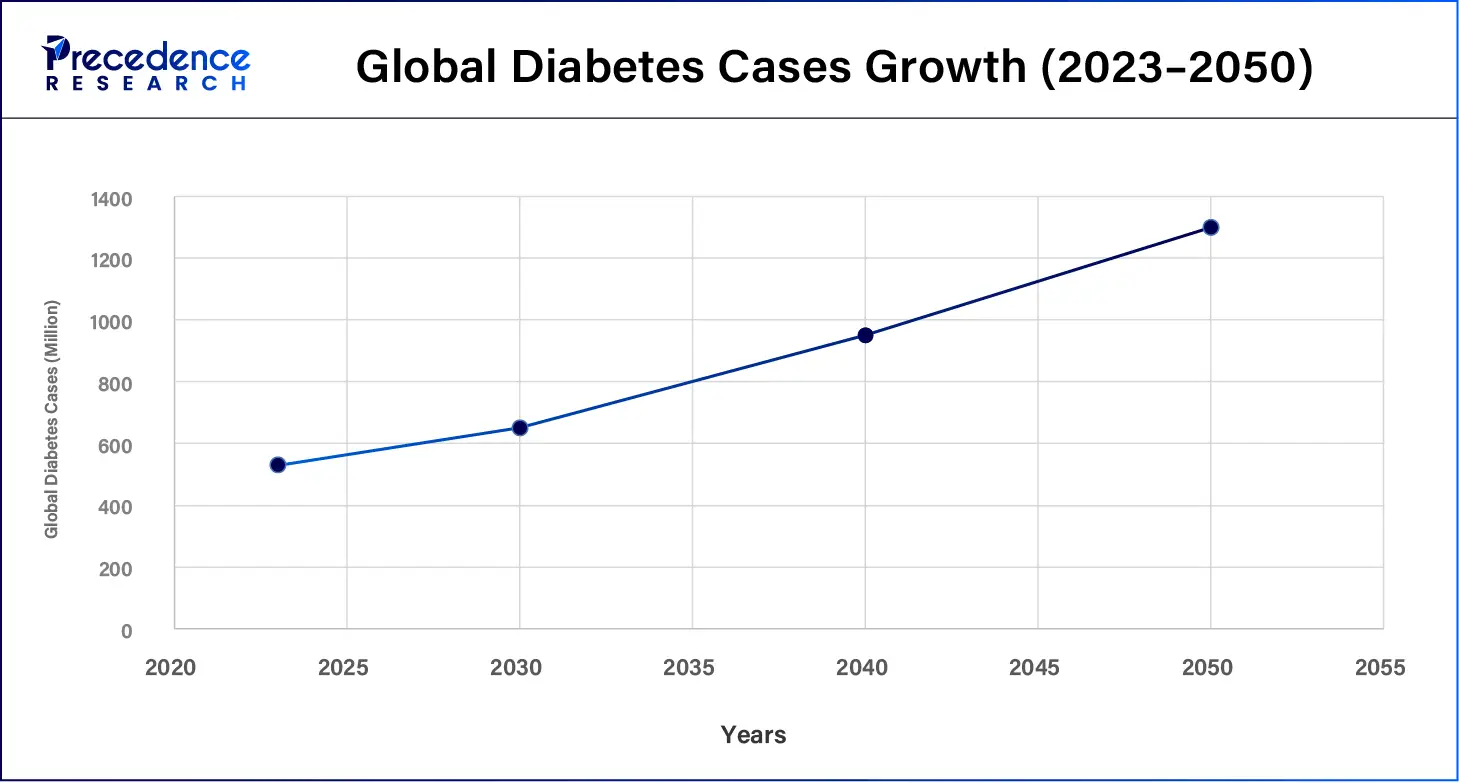
High production costs
High production costs associated with low-fat cheese are expected to restrain the low fat cheese market growth. Low-fat cheese involves a special sort of processing where fat has to be either separated or minimized in the production of cheese. Such processes require costly inputs, increased stages in utilization, and the incorporation of modern technologies. This, in turn, makes the low-fat cheese products expensive to produce compared to normal cheese products. Moreover, the price-conscious customers and sort of pricing gap curtails broader market access and penetration.
Increasing innovation in product development
The rising focus on product innovation offers favorable opportunities for the players competing in the low fat cheese market. New ideas and research in food science are allowing companies to come up with new products with improved flavors and mouthfeel while being low-fat cheese products for consumers. Newer emulsifying salts and fat replacements enable manufacturers to enhance the taste, texture, and appearance of low-fat cheese while still providing health benefits.
The ricotta segment held a dominant presence in the low fat cheese market in 2023, due to an increase in the consumers’ demand for healthy edible products. Highlighting the nutritional value of Ricotta as the cheese product contains lower fat content and comparatively higher protein than most of the cheese products being produced this was in line. Furthermore, the consumers seeking low-fat cheeses for heart health and weight control.
The mozzarella sticks segment is expected to grow at the fastest rate in the low fat cheese market during the forecast period of 2024 to 2034, owing to the rising consumption of low-fat snack products, especially in the United States and Europe. Moreover, the health campaign by the government, including ‘The Healthy Eating Initiative’ supported by the U.S. government, also contributed to segment growth.
The retail segment accounted for a considerable share of the low fat cheese market in 2023. With the increased in-store space, more and more supermarket chain stores like Walmart and Tesco, which are located in urban and suburban areas, make it easy for customers to obtain low-fat cheese products. Increased health consciousness among millennials and Gen Z, adding to greater utilization of low-fat cheeses, indirectly improved the performance in the retail outlets. New governmental campaigns for a better quality diet, including the FDA nutrition labeling regulations, raised consumers’ awareness of the utility and propelled sales. Furthermore, the fat cheese in different varieties was available at cheaper rates in retail outlets.
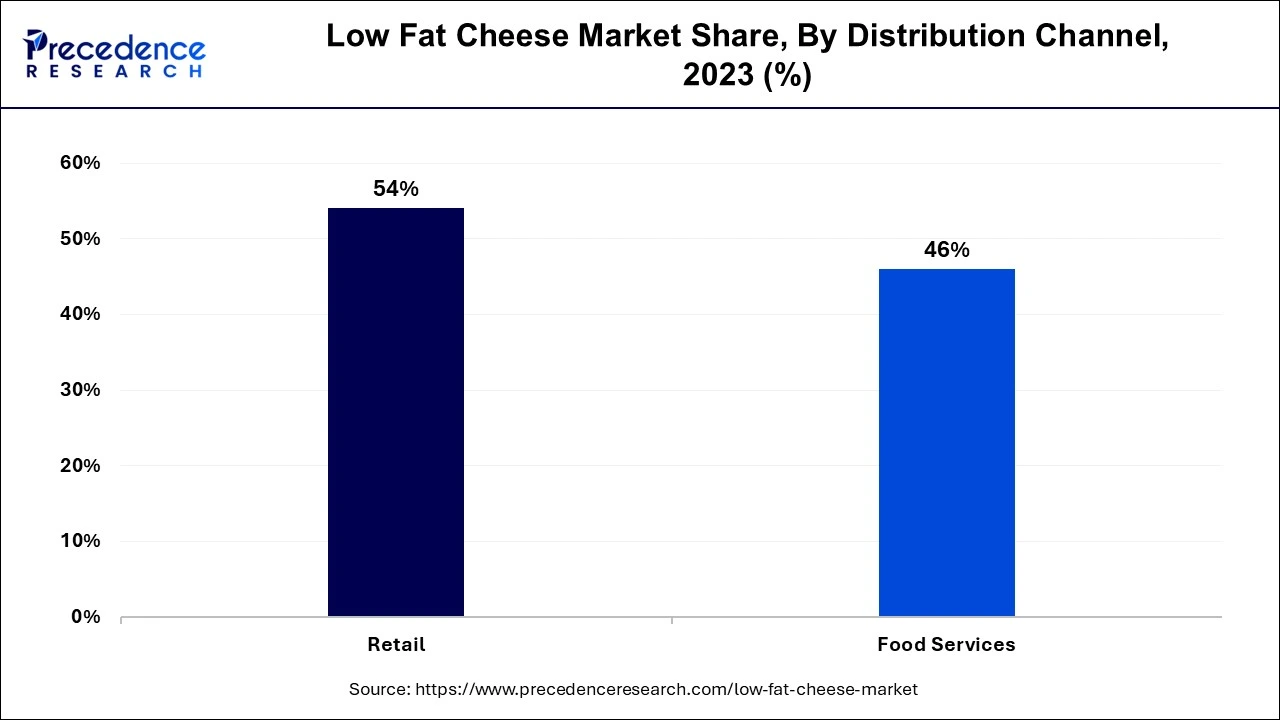
The food services segment is anticipated to grow with the highest CAGR in the low fat cheese market during the studied years, owing to the health-conscious consumers’ propensity to order foods containing low-fat cheese. According to the report by the National Restaurant Association, the trend of low-fat and plant-based products is quickly becoming popular in the food services industry. Furthermore, the USDA has also found an upsurge in the emergence of food service outlets that are adding low-fat cheese to pizzas, salads, and sandwiches. This change is in line with the growing trend in demand for places that serve healthy food, further facilitating the demand for low-fat cheese products.
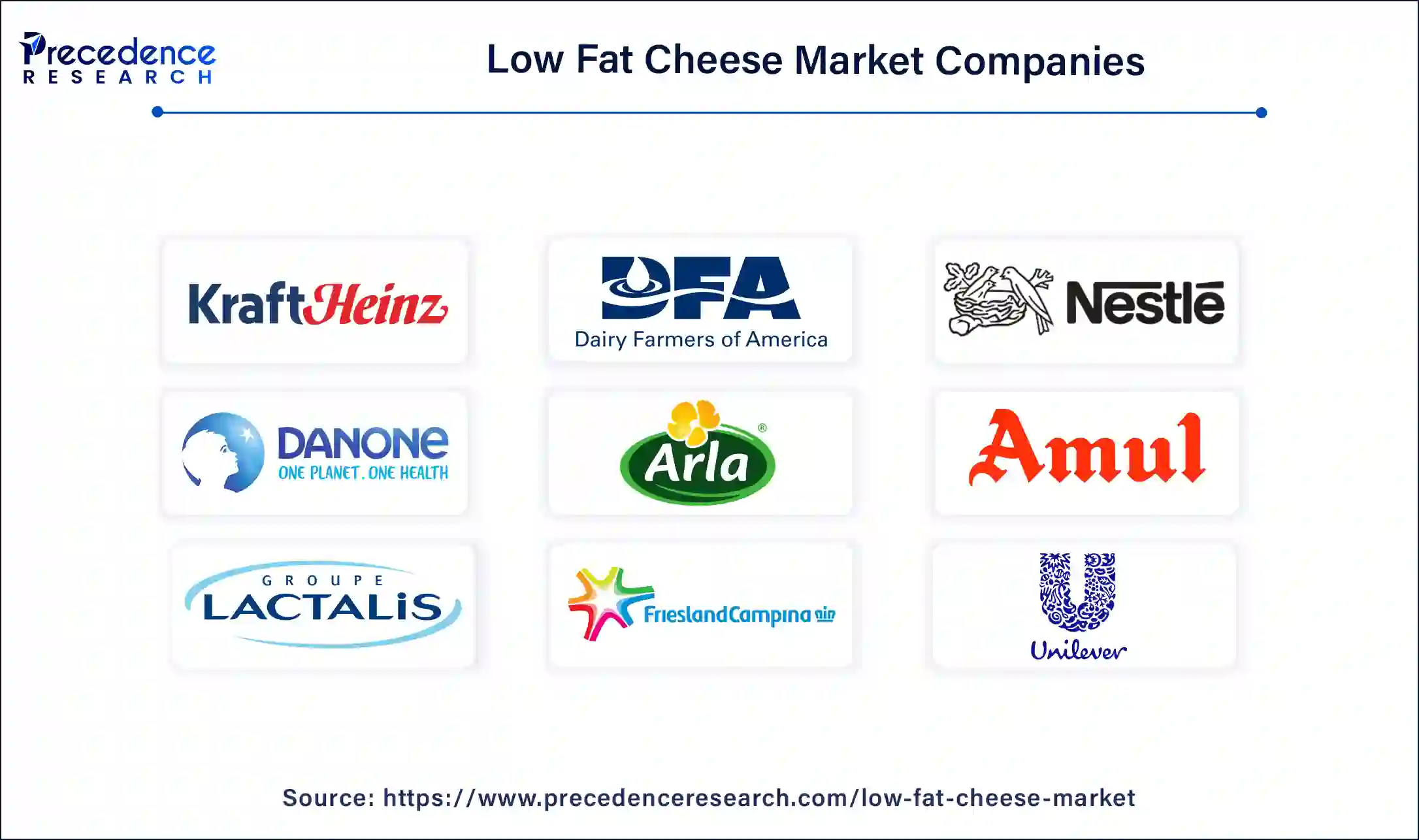
Segments Covered in the Report
By Product
By Distribution Channel
By Geography
For inquiries regarding discounts, bulk purchases, or customization requests, please contact us at sales@precedenceresearch.com
No cookie-cutter, only authentic analysis – take the 1st step to become a Precedence Research client
December 2024
October 2024
April 2024
February 2024